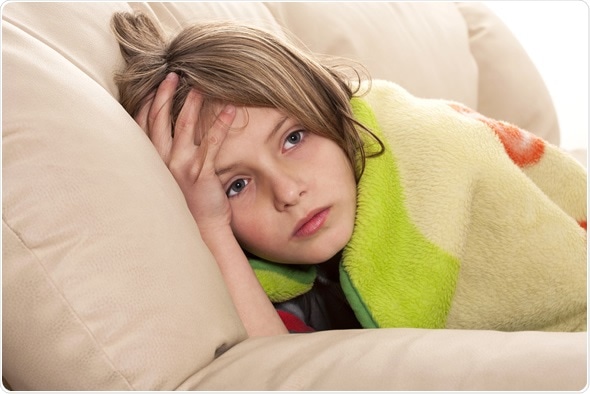Headaches are very common among children and are not usually a sign of a serious underlying condition. The headaches are often caused by stress, anxiety, depression, lifestyle, minor head trauma and common illnesses such as colds, flu and ear infections. The headaches can usually be treated with over-the-counter medications and lifestyle changes.

Image Copyright: panco971 / Shutterstock, Inc
Types of Headache
As with adults, children can develop various different types of headache, with the most common types being migraine and muscle tension headaches. The symptoms children develop tend to be different from those seen in adults. For example, when a child experiences a migraine, the pain may last for less than four hours, where as it can last a lot longer in adults. The different symptoms children experience can make it difficult to diagnose the exact type of headache a child has, but usually, it is possible to categorize the headache. In general, they are classified as the following:
Migraine
These are severe, episodic headaches that are associated with the following symptoms:
- Pounding or pulsating head pain
- Nausea and vomiting
- Abdominal pain
- Sensitivity to light and noise
- Pain that becomes worse on exertion
Tension-Type Headaches
Tension headaches occur on a daily or periodic basis and may last anywhere from half-an-hour to several days. Tension headaches do not usually cause the same signs and symptoms seen in migraine. Symptoms may include:
- Tension in the head or neck muscles
- Pain that does not intensify with exertion
- A non-throbbing, mild-to-moderate pain felt on both sides of the head
- Absence of the nausea and vomiting often seen with migraine
Cluster Headache
Cluster headaches usually occur in a series of at least five episodes, with the child experiencing anything from one headache every other day to eight headaches per day. Symptoms include the following:
- Sharp pain in one side of the head lasting less than three hours
- Congestion
- Runny nose
- Restlessness
- Irritability
Chronic Daily Headache
This is the term used to describe migraines and tension-type headaches that are experienced at least 15 days a month. They may be caused by pain relief medications, infection or head trauma.
Diagnosis
In order to establish the correct headache diagnosis, a doctor is likely to follow the following steps to learn about the nature of a child’s headache:
Obtaining headache history – The most essential step in headache evaluation is the headache history. A doctor will ask both the child and their parents to describe in detail the symptoms and characteristics of the headaches such as frequency and pain severity.
Physical examination – The child’s height, weight, head circumference, heart rate and blood pressure are measured and the head, eyes, neck, spine and shoulders are examined.
Neurological exam – The child is assessed for any problems with coordination, sensation or movement.
Other tests that may be performed to confirm a diagnosis or rule out any other conditions include magnetic resonance imaging, to produce detailed images of the brain; computed tomography, to obtain a cross-sectional image of the brain and spinal tap, where a sample of cerebrospinal fluid is extracted to check for viral or bacterial meningitis.
Treatment
In the majority of cases, resting in a noise-free environment, taking over-the counter pain relief medication and drinking plenty of fluid is enough to relieve the headache symptoms. Prescription drugs are also available that are safe and effective for treating migraines in children aged more than 6 years. If anxiety or depression are thought to be triggering or worsening headaches, then relaxation and stress management strategies may be helpful.
Relaxation techniques can help to reduce the pain or frequency of the headaches and these include the following:
- Deep breathing exercises
- Meditation
- Yoga
- Muscle stretching and relaxation exercises
- Regular breaks from activities that may trigger headaches such as strenuous exercise, studying or using a computer for long periods
- Relaxing to music
Another relaxation technique is biofeedback training, where the child is connected to devices that provide information on muscle tension, heart rate and breathing. This helps the child learn how to control certain body responses that can lead to tension and pain.
Further Reading
Last Updated: Feb 26, 2019